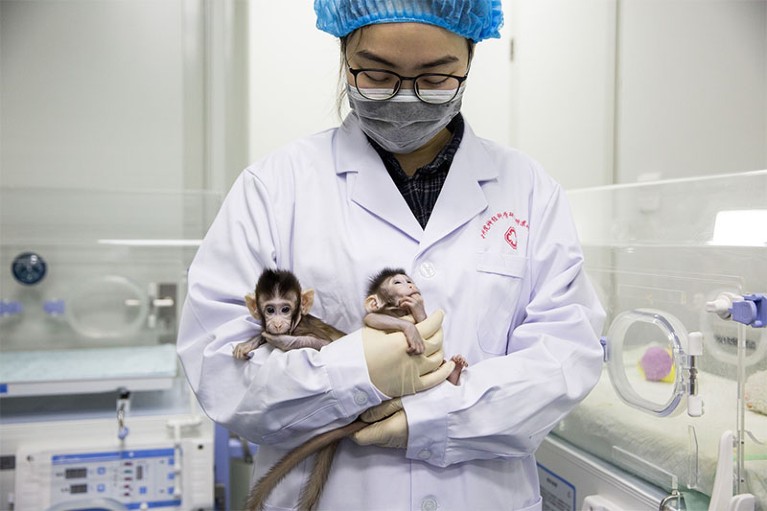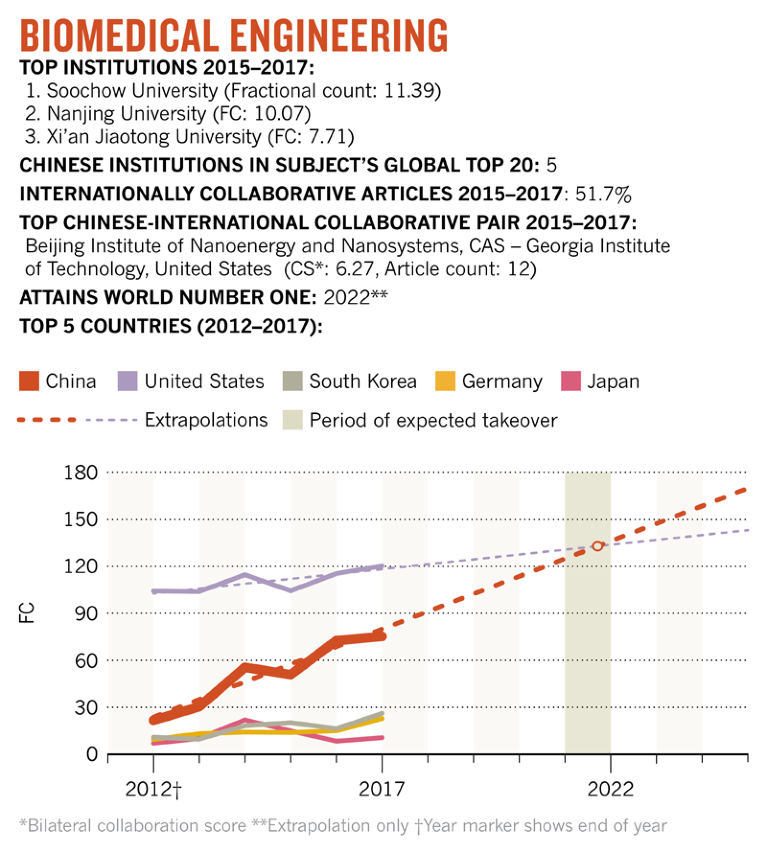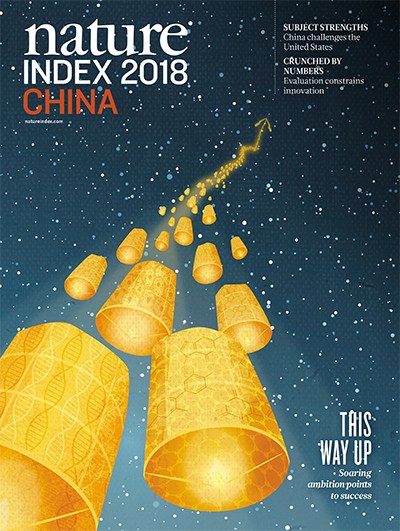
Genetically identical cloned monkeys Zhong Zhong and Hua Hua are the first primates to emerge from the method that produced Dolly the sheep.Credit: Jin Liwang/Xinhua/eyevine
For the past 20 years, French neuroscientist Erwan Bezard has spent at least one week every two months in Beijing. Bezard makes the long journey from France to visit the primates bred in Chinese labs.
China has become the top destination for research involving these animals, which are invaluable models for studying human disease. Other countries do not breed the primates in such large numbers or to the standard produced in China.
“Some 95% of papers using transgenic monkeys come from China,” says Bezard, director of the Institute of Neurodegenerative Diseases at the University of Bordeaux, and manager of his own lab at the Institute of Laboratory Animal Sciences, Chinese Academy of Medical Sciences. Among recent breakthroughs, researchers at the Chinese Academy of Sciences (CAS) have genetically modified cynomolgus monkeys so they exhibit autistic-like behaviours, to better understand what causes the disorder, and how to treat it. CAS scientists have also cloned primates using a technique similar to the one that produced Dolly the sheep. Bezard has used rhesus monkeys to show how brain–computer interfaces can restore leg movement after spinal cord injury.
These developments have coincided with improvements in the regulation and enforcement of international standards in the biosciences in China. Two events were critical to the process: the 2003 SARS outbreak, which put a spotlight on the issue of wildlife and lab animal management, and the creation in China of the world’s first human–rabbit embryos in 2001, which provoked an international public relations crisis for the country.
The Chinese government recognizes that bioscience will play a major role in its global competitiveness. Biomedicine, synthetic biology and regenerative medical techniques are listed as strategic fields and industries in China’s 13th Five-Year Plan. “China doesn’t want to miss the life-science biotech revolution,” says Cao Cong, an innovation studies researcher at the University of Nottingham Ningbo China.
Scientists have also realized that to gain global recognition for their achievements, they must play by internationally accepted rules, says Du Yanan, a biomedical engineer at Tsinghua University, who returned to China in 2010 after three years at Harvard-MIT Health Sciences and Technology.
Chinese life scientists have used advanced medical imaging technology to better detect malignant nodules in the lungs, created the first monkeys using the CRISPR–Cas9 gene-editing technique, and discovered that fetal DNA flows through the mother’s bloodstream. That advance led to the development of a non-invasive test for Down’s syndrome during pregnancy, which is used around the world.
In the Nature Index, China is the second leading contributor to biomedical engineering articles after the United States, measured by its contribution to the authorship of papers in 82 high-quality research journals in 2015–17.
Cross-examined
In 2001, such advances were unthinkable. In September of that year, Chinese newspapers reported that Chen Xigu, a scientist at Sun Yat-sen University in Guangzhou, had successfully grown rabbit embryos injected with skin-cell nuclei taken from a seven-year-old boy.
“At that time, no one thought that China could make such a breakthrough,” says Joy Zhang, a sociologist at the University of Kent in the United Kingdom. The resulting hybrids could be used to derive human embryonic stem cells, useful for regenerative medicine.
The national response was buoyant, but brief. Within days, there was international outcry over the research and China was being called the ‘Wild East’ of biology. Startled by the furore, the government effectively banned all hybrid embryonic stem cell research, says Zhang. Chen’s hybrid research came to an abrupt end, though he remained on the Sun Yat-sen faculty and continued to supervise students, particularly on somatic (non-reproductive) stem cells.
China’s bioethics landscape has evolved since the incident. In 2003, the Ministry of Science and Technology and the then Ministry of Health (MoH) issued guidelines for human embryonic stem cell research. Between 2009 and 2013, the MoH introduced administrative measures and regulations governing the clinical application of medical technology and stem cells. A national standard for lab animal institutions came into effect in 2014.
Zhang describes the government’s regulatory approach as pragmatic, in which it “copy-pastes” international regulations, largely following the relatively permissive stance of the UK. By clearing the regulatory route for research, says Zhang, China has attracted many overseas-Chinese scientists and non-Chinese collaborators. “Permissive regulation has helped China’s quick ascent,” says Zhang.

Source: Nature Index/Dimensions from Digital Science
Informed consent
On his return to Beijing in 2010, Du experienced lab-culture shock. Researchers were raising lab animals under varying conditions and killing them without humane procedures. Doctors were handing over patient samples to researchers without patient consent.
These practices, although expedient, come with serious risks. Unscrupulous behaviour opens science to criticism, and can make research ineligible for publication in top journals. And, the failure to follow procedures undermines the reproducibility of the results.
Submissions to many reputable journals must be accompanied by approvals from ethics committees. In the years since his return, Du — who has co-authored several recent papers on methods for introducing stem cells into the body — has witnessed great progress in biomedical research ethics.
For example, the first accreditation of a Chinese facility by the Association for Assessment and Accreditation of Laboratory Animal Care International (AAALAC International) was in 2006; by 2016 around 60 Chinese programmes were accredited by this organization, a non-profit promoting the responsible care and use of animals in science under a voluntary certification framework. China has also begun to take more initiative in global policy debates and set standards in emerging fields, such as stem cells and synthetic biology.
When in 2015, Chinese researchers became the first to use CRISPR on nonviable human embryos, sparking another global ethics debate, the government’s response was much more measured than it had been in the recent past, says Zhang. The government clarified its position and regulatory procedures, specifying that embryo gene editing is permitted in China for basic and preclinical research, but prohibited for clinical or reproductive use.
Vast backyard
But, in ethical practice, Chinese science remains highly variable. Decisions about how to implement broad-brush guidelines are left to the discretion of institutions and researchers. The recent claims of genome-edited twins by He Jiankui at the Southern University of Science and Technology of China (SUSTech), which SUSTech has distanced itself from and more than 100 Chinese biomedical researchers have strongly condemned, is a case in point.
Implementation remains patchy, says Du, especially in universities and hospitals in remote regions. When it comes to enforcing standard practices across the whole of China, he says, “we still have a long way to go.”
Part of the problem, says Zhang, is one of communication. Good enforcement, she says, requires not just top-down monitoring, but also engagement with the public about “what they should expect and what they are, by law, entitled to.” A failure to interact with public interest groups about the rules facilitates the spread of rumours, misconceptions and distrust in science, says Zhang.


 All eyes on the prize
All eyes on the prize
 Ongoing challenge
Ongoing challenge
 Yielding results to feed a people
Yielding results to feed a people
 China’s place among the stars
China’s place among the stars
 Small science grows large in new hands
Small science grows large in new hands
 Strong spending compounds chemistry prowess
Strong spending compounds chemistry prowess
 Quality deficit belies the hype
Quality deficit belies the hype
 Citations strength begins at home
Citations strength begins at home
 Partner content: Make your mark in the city of makers
Partner content: Make your mark in the city of makers
 Partner content: A non-stop route to collaborative discovery
Partner content: A non-stop route to collaborative discovery
 Partner content: Melbourne, Victoria — Number 1 in Australia for medical research and biotechnology
Partner content: Melbourne, Victoria — Number 1 in Australia for medical research and biotechnology








